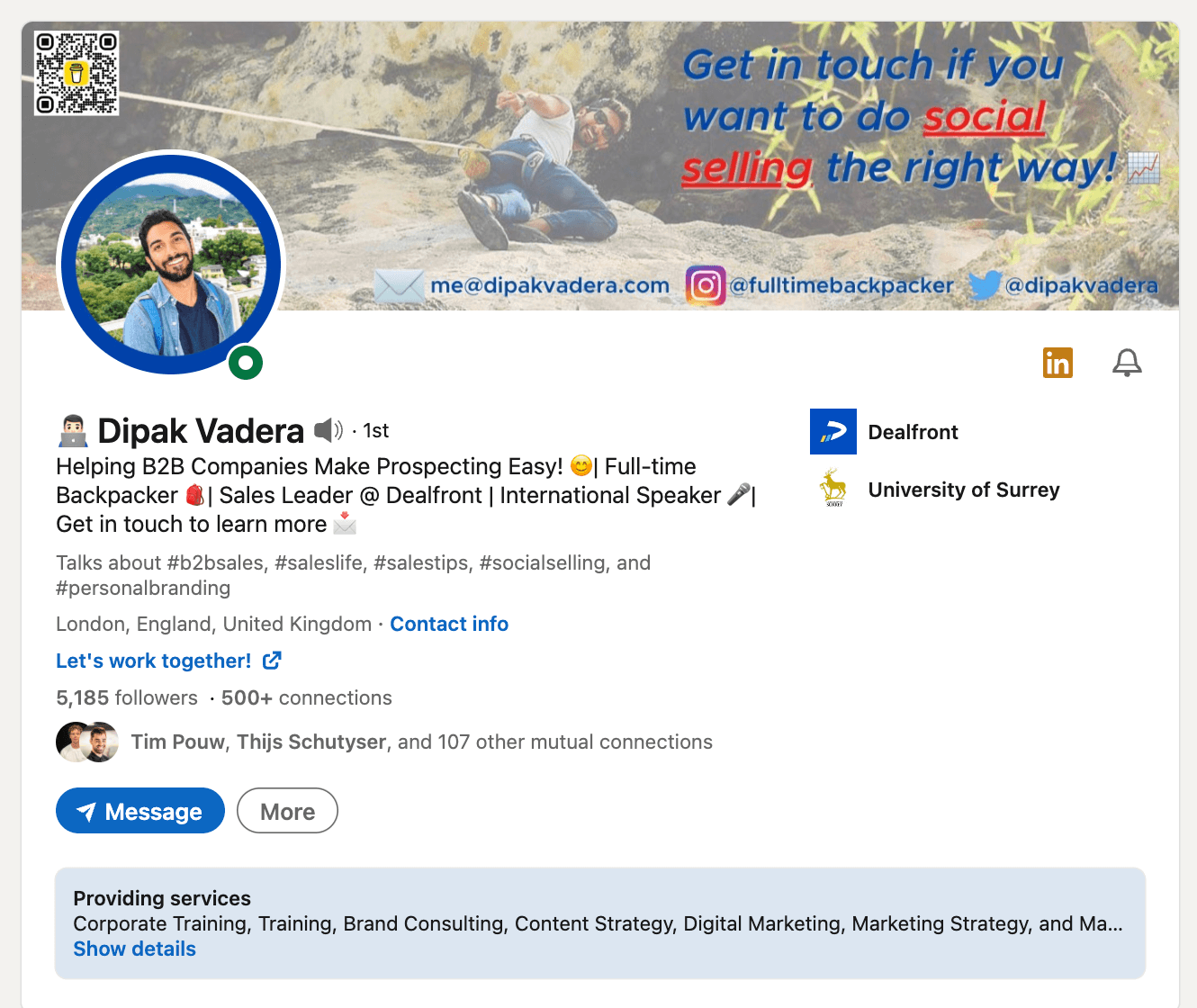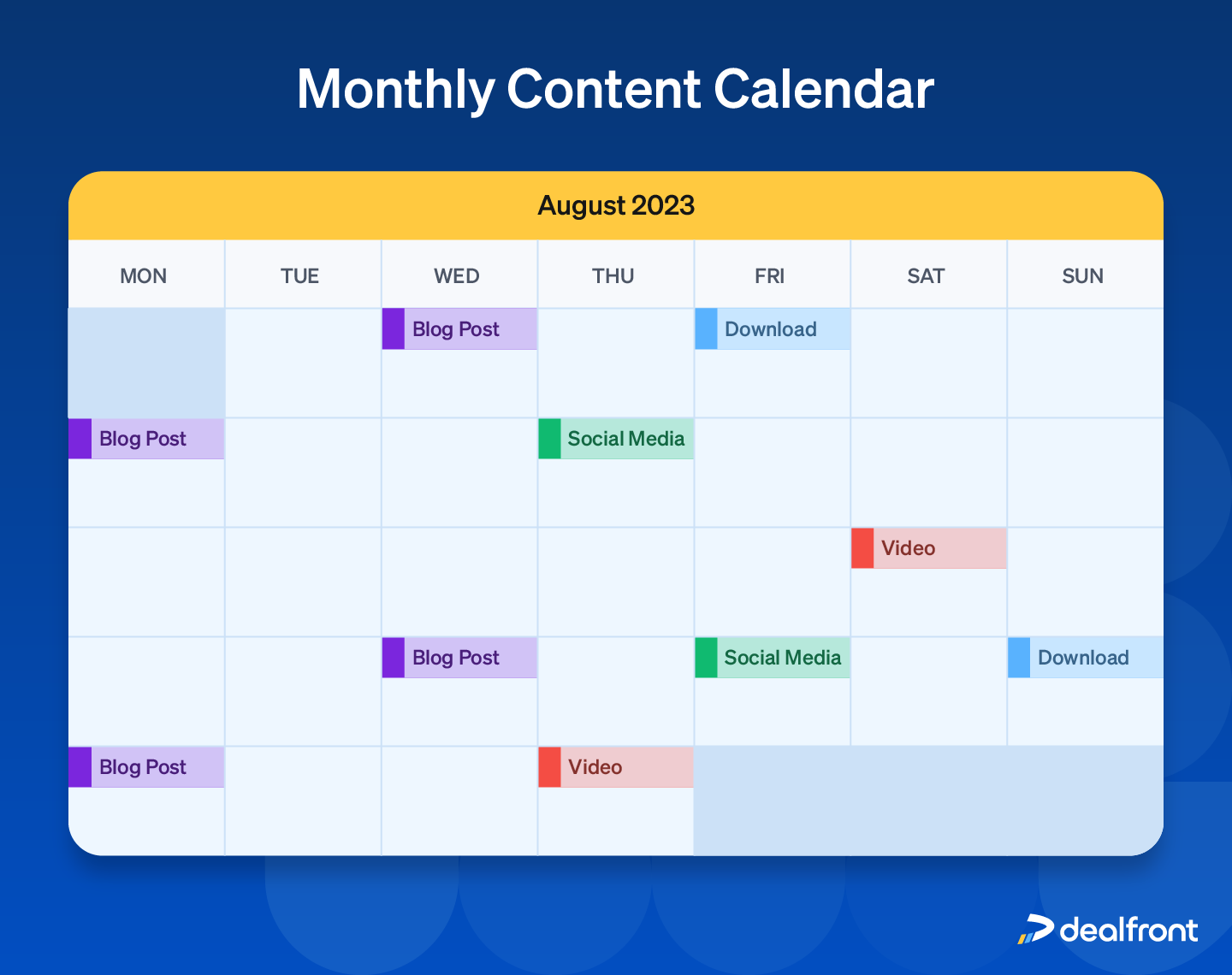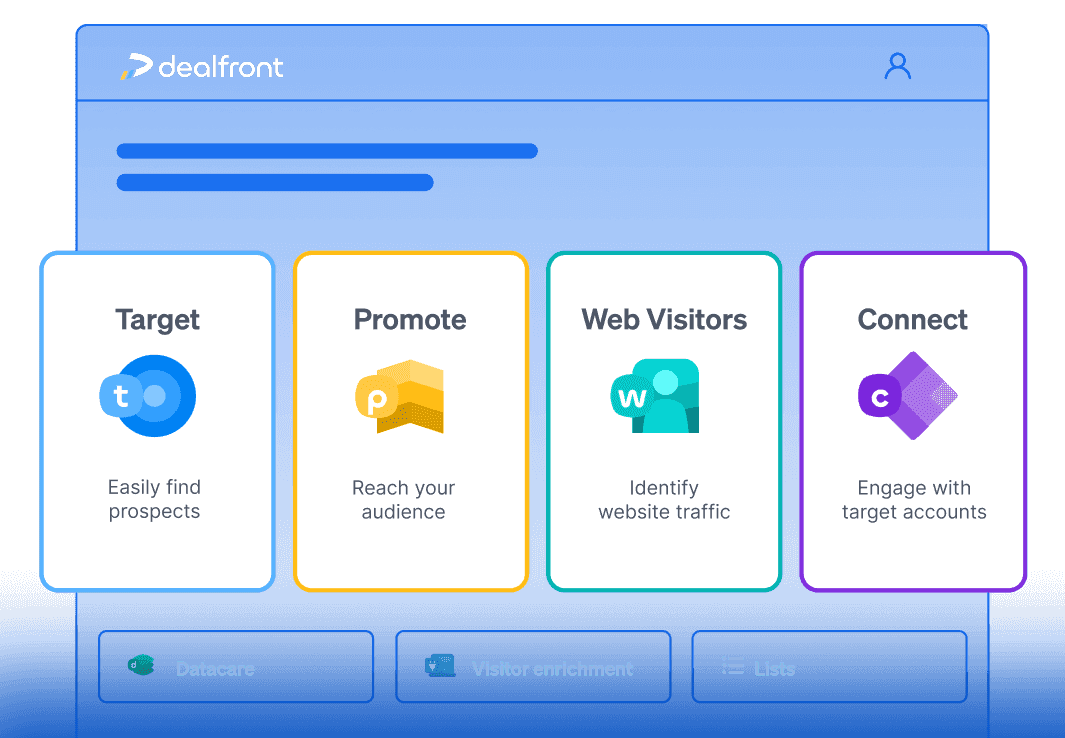Personal branding has become a vital strategy for entrepreneurs and professionals aiming to excel in social selling. Building a strong personal brand allows you to showcase your expertise, connect with your target audience, and establish yourself as a thought leader in your industry.
Most importantly, a personal brand on social media helps you sell more. For example, 2022 data from LinkedIn shows that “78% of social sellers outsell peers who don’t use social media.”
In this article, you’ll learn how to create a personal brand and discover little-known, practical tips for getting started. We’ll also reveal personal brand examples for inspiration. Let’s dive in.
What is a personal brand?
At its core, a personal brand refers to the intentional shaping and promotion of your professional identity. Personal branding involves showcasing your skills, expertise, and unique personality to establish credibility, build trust, and attract opportunities.

In the context of social selling, a personal brand helps you stand out from the competition and establish yourself as a trusted authority in your niche.
What is social selling?
Social selling is finding, connecting with, understanding, and nurturing sales prospects, all on social media.
Dipak Vadera, Director, PLG Sales at Dealfront
Social selling is a strategic approach to relationship-building for sales that leverages the power of social networks to engage with potential customers and build meaningful relationships. With social selling techniques, you can tap into a vast pool of prospects and establish authentic connections that drive business growth.
Ways to build your personal brand on social media
Now that we covered the social selling and personal brand definitions, let’s see how to create a personal brand on social media.
Establish a niche
The first step in creating a strong personal brand is identifying a niche within your industry. Focus on a specific area where you can position yourself as an expert and expand later. You need to embrace your unique strengths and offer valuable insights within your chosen niche.
Establish a consistent brand voice
Authenticity is key to any successful personal brand strategy for social selling. Instead of trying to sell aggressively, use natural language to showcase your experience and provide valuable information. Let your brand voice reflect your expertise and resonate with your target audience. Consistency in messaging and tone helps establish trust and familiarity.
Establish a consistent style of posting
Consistency in posting is crucial for maintaining an engaged audience. Develop a posting schedule and stick to it. For example, you can create a weekly carousel post highlighting your biggest takeaways from the previous week.
By delivering content consistently, you train your audience to expect and seek your valuable insights.
Post consistently on LinkedIn
When I just started publishing on LinkedIn daily, I was getting 10,000+ impressions a week) and I was growing my followers by +50 a week. It shows that only consistent actions will give you results.
Romana Hoekstra, Content Marketing Expert
LinkedIn is a powerful platform for personal branding and social selling. Use it to your advantage by publishing content regularly and following a predetermined schedule. Whether it’s daily posts at 8 am or specific days of the week at 11 am, maintain consistency.
Additionally, engage with your audience by responding to comments on your posts and actively participating in relevant discussions on other thought leaders’ content. It will help you expand your area of expertise and gain new followers.
Make industry “friends” on social media platforms
Building relationships with influencers and thought leaders within your industry can greatly benefit your brand on social media. You’ll gain valuable insights and industry knowledge and an opportunity to put yourself in front of the followers of your connections.
Add a discussion after the passage above: Moreover, integrating personal selling techniques into your social media strategy can further enhance your efforts by allowing for direct and personalized interactions with potential clients, ultimately leading to increased sales and business growth.
Author guest posts
Partner with industry publications and websites to write guest posts and increase your visibility on social media even further. For instance, you can repurpose posts on your LinkedIn profile as articles. Only ensure you use the correct tags and wait for a bit (a week, for example) before republishing articles so the original publisher has initial exclusivity.
When you share or publish these articles, the original publisher is likely to like, share, or engage with your content, further exposing your profile to their followers.
Do research
If you want to build a strong personal brand for social selling, ensure you stay current on what engages your audience. Keep an eye on popular, trending hashtags to discover the topics that capture people’s attention.
In addition to content and hashtag trends, stay up to date with changes in social media algorithms, which are constantly shifting. Familiarize yourself with the differences in how the algorithms on different platforms work. For example, did you know that on TikTok, follower count doesn’t matter nearly as much as on other platforms?
Engage often
Engaging with relevant content by leaving thoughtful comments is vital to building a personal brand. You can significantly impact your visibility and reputation by commenting on at least three to five posts per day, focusing on quality rather than quantity.
By consistently adding value to conversations, you can establish yourself as a trusted authority and attract a larger following, ultimately boosting your social media presence and expanding your reach.
Make video content
Video gives you more opportunities to be creative than text, from images and props to ridiculously engaging ideas.
Joe Henson, Senior PLG Account Executive at Dealfront
Video content is highly engaging and can set you apart from others in your industry because you can use it to show your personality and connect with your audience as a real person. As prospects find you on social media, you can even follow up by incorporating video into your emails, as Dealfront’s Joe Henson does by embedding GIFs that link to videos into his emails.
Another excellent example of using video content to enhance personal branding efforts comes from Dealfront’s Romana Hoekstra, who earned significant LinkedIn engagement with a video that introduced the counterintuitive concept of “zero-click content.”
Focus on helpful content
When crafting content, prioritize delivering value and practical solutions. Rather than reiterating readily available information through a simple Google search, concentrate on providing unique insights, actionable tips, and genuine advice. Roundups of the latest news and data in your industry can also be helpful for people who don’t have time to seek it out themselves.
How to kick-start creating a personal brand
Getting started with your brand doesn’t have to be time-consuming. In fact, you can kick things off in three easy steps that we share below.
Update your accounts to reflect your goals and brand
Take the time to review and update your social media accounts to align with your personal brand goals. As an example, check out the LinkedIn profile of Dealfront’s Director of PLG Sales, Dipak Vadera:

Vadera found a niche as a B2B SaaS backpacker in sales with a focus on social selling. His LinkedIn profile thoroughly reflects that brand, not only in the banner but in frequent posts that include travel updates and videos on social selling.
Create branding (see more in the distribution section)
Maintaining consistency is critical across all branding aspects, not only written content. By establishing a recognizable and consistent visual identity, you strengthen your brand.
Therefore, pick a color palette and two to three fonts that align with your brand and use them consistently across your social media profiles. You can also use Canva templates for carousels and other formats to create visually appealing and cohesive posts.
Canva even allows you to create a “brand kit” that preloads your fonts and colors. This makes brand consistency that much easier. And if you’re having trouble picking brand assets, Canva has helpful suggestions to make the process faster.
Create a content calendar
A content calendar is a helpful tool that bloggers, influencers, brands, and publications use to effectively organize and manage the creation and distribution of informative and promotional content across various platforms.

Here are five simple steps to establish your content calendar:
Begin by researching your target audience, observing their online activities, and understanding what they find engaging and share-worthy.
Determine key messages that resonate with your audience, ensuring a balanced mix of informative and promotional content to keep them interested.
Select the platforms where your audience is most active and invest your time and efforts accordingly, focusing on those channels that receive the most attention.
Plan your content calendar for the upcoming quarter, visualizing it in a convenient format like a Google Calendar. Post three times a week to start. Lay out what you’re going to post on each date, create it in Canva, and schedule it with a tool like Buffer or Hootsuite.
After following your content calendar for a couple of weeks, analyze the results you’ve achieved. Optimize your strategy by doubling down platforms that have shown better performance and scaling back on those that haven’t.
By implementing these steps and regularly reviewing your content calendar’s impact, you can fine-tune your approach and maximize the effectiveness of your digital marketing efforts.
How to distribute content on social media
With the sheer number of social media platforms available, it can be overwhelming to decide how to post across those you’ve decided to focus on. Try some of the tips below to streamline your process.
Use a social management tool or posting tool
Posting or social management tools can simplify the entire content distribution process on social media. Consider using these two tools to start out:
Canva
Use Canva to set yourself up for easy success, paying for premium and setting up your brand profile. Part of establishing consistency is creating your branding, even if it’s just the same Canva template with your “@” in the corner.
Descript
Using AI (artificial intelligence), Descript automatically transcribes your audio, providing you with a text-based editor. Simply highlight and delete or move words or sections to refine your recordings. With a few clicks, you can eliminate filler words like “ums” and “uhs” and effortlessly incorporate transitions, animated captions, and other effects to enhance your videos.
Repurpose content across your decided-upon channels
Give your content new life by repurposing it across various social media platforms, tailoring it to fit each platform’s style and audience. If you find yourself lacking ideas, don’t hesitate to repurpose content from your own company and inject it with your unique perspective.
For example, did you share a valuable statistic in your recent blog post? Consider creating an engaging Instagram post or sharing a screenshot on your Instagram story. Or you can transform the key points from your YouTube videos into Instagram reels.
Experts like Gary Vee excel at repurposing video content into engaging shorts on Instagram and TikTok.
Choose the right platforms
Identify the social media platforms where your target audience is most active. Focus your efforts on those platforms to maximize your reach and engagement. Some questions to ask yourself about your audience are:
What’s their age?
What’s their gender?
What’s their occupation?
What hobbies or interests do they have?
Where do they spend the most time online?
You can get even more granular with a tool like Dealfront Target, Europe’s largest B2B database with over 30 million companies and over 89 million contact details. Target offers over 100 powerful filtering options to create prospect lists, including industry, location, company size, job title, zip codes, and more.
With a precisely defined target audience, you can find out which social media platform most of your prospects are on, research the content they’re sharing, and plan accordingly.
Focus on 1-2 platforms to start
Don’t overwhelm yourself by trying to conquer every platform at once; instead, choose one or two to start with as you build your social media marketing skills.
By concentrating on a select few platforms, you can dedicate more time and energy to understanding the nuances of each platform, creating high-quality content, and engaging with your audience effectively. As you establish your brand and gain momentum, you can gradually expand to other platforms.
Use different formats
Remember to use different content formats on social media. Currently, the carousel is on the rise, but you’ll also want to test videos, long-form posts, LinkedIn articles, and simple graphics.
Testing different formats lets you cater to various preferences and capture the attention of diverse audiences. By diversifying your content formats, you can showcase your expertise, engage your followers, and keep your content fresh and engaging.
Leverage Quora
Quora is an underrated platform that can help boost your brand through audience research. With over 700 million visits per month, Quora is a great place to reach people searching for questions you are set to answer.
Set up a Slack channel at work dedicated to engaging with other employees' content
Create a dedicated Slack channel (ours is called #social-media) for employees to share content. Encourage engagement by having colleagues like, share, and comment on each other's posts. This practice boosts visibility and engagement for your organization.
Benefits of maintaining a personal brand in the B2B industry
Here are the three biggest advantages of developing and maintaining a personal brand to consider before you start your journey:
People trust people, not brands
A strong personal brand helps you establish trust and credibility with your target audience. People are more likely to engage with individuals they can relate to and trust than with faceless brands.
This could be why recent research shows that small brands have four times the rate of engagement on live videos than large brands—encouraging data if you’re just starting with building your brand.
Social media is casual and allows you to engage with prospects in a more natural way
Social media networks provide a casual and interactive environment to engage with prospects in a more natural and personalized manner. By using social selling techniques, you can build meaningful relationships and establish a positive reputation within the B2B world.
Great way to network and have more possibilities in the B2B world
A robust personal brand opens doors to new networking opportunities and expands your possibilities within the B2B industry. By actively building your personal brand, you increase your chances of connecting with like-minded professionals, potential clients, and industry leaders.
How to come up with content for social media
Coming up with engaging and relevant content for social media can be challenging, but there are several strategies you can employ to stay inspired:
Repurpose content from relevant hashtags. By exploring popular hashtags within your industry or niche, you can find existing content that resonates with your target audience and put your spin on it.
Draw inspiration from successful B2C (business-to-consumer) content. B2C brands often excel at social media, and you can adapt their tactics to your B2B audience. For example, you could be the first in your industry to do “day in the life” or “get ready with me” videos on your work routine.
Look at questions on HARO (Help a Reporter Out) and answer them on social media. Journalists use HARO to ask questions they need to answer in their articles. This means people are looking for that information, so it’s worth your time simply answering these questions on social media.
Look for questions in the comments section of popular posts and create your posts to answer those questions. Such a practice allows you to address specific concerns and provide solutions your audience seeks.
Explore Quora’s top questions within your niche. You can answer these questions on Quora or use them as inspiration for social media and blog posts.
Study different content formats. Take inspiration from someone’s short post to create a long-form article for LinkedIn or your blog.
Document and keep concepts. Write your ideas on your phone or computer as they come to you so you always have a backlog of content ideas. You can also save other people’s content on platforms like LinkedIn to review when out of ideas. Putting your spin on it will give your audience a fresh perspective.
Don’t be afraid to share strong opinions as part of your personal branding strategy. They lead to more engagement, and most engagement is good, even if it’s “bad.”
By employing these strategies and maintaining a consistent flow of valuable content, you can successfully overcome the challenge of generating engaging and relevant content for your personal brand on social media.
Consistency is your key to success
Creating a personal brand for social selling is a powerful strategy for B2B professionals and entrepreneurs. You can build brand awareness and attract your target audience by establishing a niche, developing a consistent brand voice, posting regularly on social media channels, and using the right tools.
And all this doesn’t have to take hours a day.

With a streamlined process, personal branding for social selling can be a simple, 30-minute daily task—one that will reap ample rewards.
If you want to build trust, engage naturally with prospects, and unlock new opportunities within the B2B landscape, learning how to create a personal brand is one of the most important things you can do. Start implementing the above strategies today and watch your personal brand thrive.







